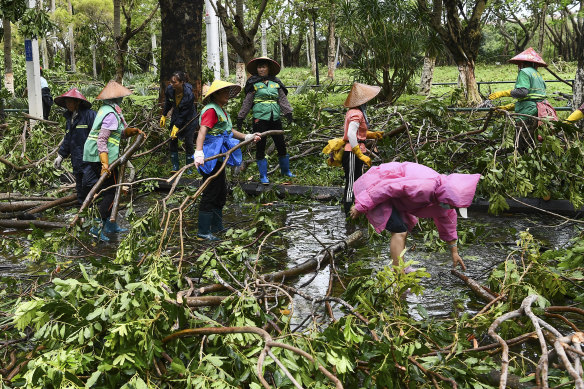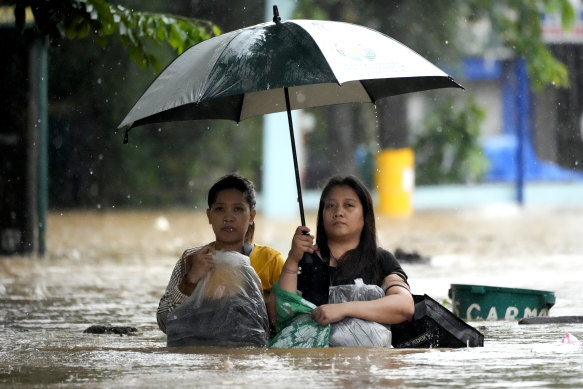
Ha Long Bay resident Nguyen Viet Anh told The New York Times his town had been devastated, with roofs ripped from homes.
“I don’t even recognise my town,” he said. “It’s just like out of a horror movie.”
On Friday afternoon, Yagi struck the Chinese city of Wenchang in Hainan province with wind speeds of up to about 245 kph near its centre. Authorities said the typhoon left three people dead and nearly a hundred others injured in the province. It has affected over 1.2 million people as of noon Saturday, according to the Global Times.
Some 420,000 Hainan residents were relocated before the typhoon’s landfall. Another half a million people in Guangdong province were evacuated before Yagi made a second landfall in the province’s Xuwen County on Friday night.

Emergency workers move in to clear fallen branches in Haikou, Hainan province, China, on Saturday, September 7, 2024. Credit: AP
Meanwhile, the meteorological observatory of the city of Haikou downgraded its typhoon signal from red to orange on Saturday, as it moved further away.
Before leaving Hong Kong, Yagi forced more than 270 people to seek refuge at temporary government shelters on Friday, and over 100 flights in the city were cancelled due to the typhoon. Heavy rain and strong winds felled dozens of trees, and trading on the stock market, bank services and schools were halted.
Yagi was still a storm when it blew out of the northwestern Philippines into the South China Sea on Wednesday, leaving at least 20 people dead and 26 others missing mostly in landslides and widespread flooding and affecting more than 2.3 million people in northern and central provinces.
More than 82,200 people were displaced from their homes in Philippine provinces, and classes, work, interisland ferry services and domestic flights were disrupted for days, including in the densely populated capital region, metropolitan Manila.

Residents protect their belongings as they negotiate a flooded street caused by heavy rains from Tropical Storm Yagi, locally called Enteng, in Cainta, Rizal province, Philippines.Credit: AP
Benjamin Horton, director of the Earth Observatory of Singapore said that storms like typhoon Yagi were “getting stronger due to climate change, primarily because warmer ocean waters provide more energy to fuel the storms, leading to increased wind speeds and heavier rainfall.”
Climate change was also causing storms to potentially move to different locations with studies by the observatory showing that the latitude where storms peaked in their intensity was shifting, exposing newer areas to the impacts of storms, he added.
Horton said that protecting natural systems ranging from reefs to rivers while building structures that were more resilient to strong winds and flying debris and improving existing infrastructure were all measures that could help countries better deal with strong typhoons.
Get a note directly from our foreign correspondents on what’s making headlines around the world. Sign up for our weekly What in the World newsletter.









 Add Category
Add Category